Coach 1306 is one of 25 former Central Railroad of New Jersey
steel commuter coaches built in 1930-1931 by Pressed Steel Car
Company.The car was sold to Green Mountain Railroad in July
16, 1984. It seats 74 in walkover coach seating.
What is today the
Dover
Harbor started life looking quite a bit different.
This heavyweight passenger car was built in July, 1923, by
the Pullman Company as the
Maple Shade. This car
was a combine baggage-library (lot 4698, Plan 2951),
featuring a four section, twelve seat lounge, a barber shop
and a twenty-eight foot baggage area. The car was assigned
to, and painted for, the Pennsylvania Railroad (Tuscan red),
and operated on many named trains, including the Broadway
Limited and the Spirit of St. Louis.
After just eleven years, the car
was rebuilt with six double bedrooms, a buffet, and a lounge
- part of a nine car Dover Series built to plan 4015. Named
the
Dover Harbor, the car even received air
conditioning. With the May 1934 rebuild, the car was painted
in the standard Pullman green and gold livery and assigned
to the Michigan Central Railroad, a subsidiary of the New
York Central Railroad. By 1939, the
Dover Harbor, Dover
Plains and
Dover Bay, operated on the
westbound
Lake Sore Limited and the eastbound
Commodore
Vanderbilt between New York City and Chicago.
In 1967, the car left Pullman ownership
for the last time when it was sold to the first of four
private owners, and eventually became the property of the
Washington, D.C. Chapter of the National Railway Historical
Society on November 30, 1979. The D.C. Chapter has worked to
rebuild the car, updating what is required to make is usable
in Amtrak service while preserving its historic
interior. According to the Chapter's website, the
Dover
Harbor is "the only heavy weight Pullman revenue car
fully operational for private use on Amtrak Passenger
trains." For more information, check out the website
www.doverharbor.com.
The
Dover Harbor is actually a
very appropriate car for operations on these former Rutland
Railroad routes. While it didn't operate on the Rutland,
between 1954 and 1965, the car was generally assigned to
operate between Washington D.C, and Montreal, Canada, on the
Washington and the
Montrealer. This means
that the
Dover Harbor was a regular at Bellows
Falls (2:33 A.M. southbound on the
Washingtonian and
2:07 A.M. northbound on the
Montrealer).
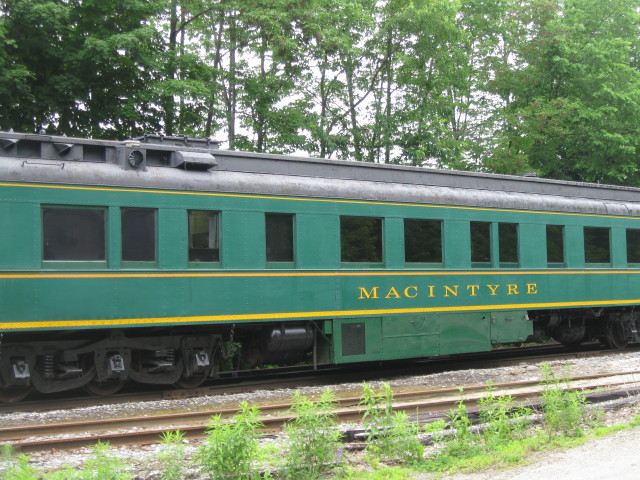 # 4 Macintyre.
# 4 Macintyre.
The business
car
Macintyre has a long and complicated
history. This 80-foot long car features an open platform
with an observation room which includes a sofa and
several observation chairs, A dining room near the
kitchen area seats six. Between the two areas are three
state rooms and two restrooms.
What is known about the car's history
is rather sketchy, but it is believed that the 80-ton
car was built in 1932 by Bethlehem Steel Company in
Baltimore, MD. The car was built as Erie #4, but was
then sold to the Grand Trunk Western. Glenn Davis,
one-time head of the Vermont State Police and later
president of the Green Mountain, bought the car and
moved it to Montpelier Jct., where he lived in it. The
car was moved to Bellows Falls when Davis became
president on the GMRC. Davis eventually sold the car to
Rock MacIntyre, president of MacIntyre Fuels. When Rock
MacIntyre ran into financial difficulties the car became
property of the VTR.
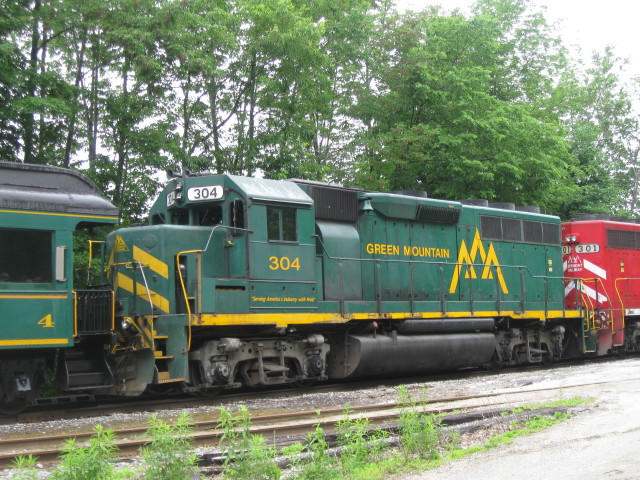
Open platform of # 4
Macintyre and GMRC 304,
Model GP40, Builder EMD, date 2/71.
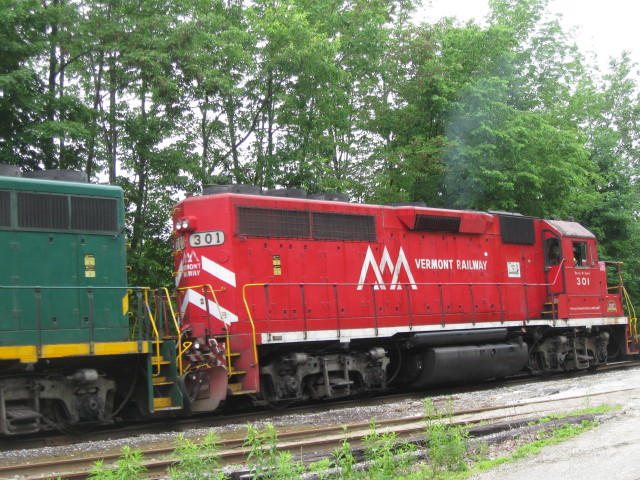
VTR 301, builder EMD, model GP40, built 5/67.
After our two
runbys were finished in Ludlow, we reboarded our
train to continue on to the Connecticut River.
MP
25.47 Smithville - At the
East Hill Road grade crossing is the Imerys Talc
American facility, built in 1974. Many know the
facility as the Luzenac Talc Mill. To supply this
processing facility, the company has several open
pit mines to the south. Talc is used for almost
everything as it is soft, water repellent,
chemically inert and highly platy. It it us used in
paper, paints, plastics, rubber, ceramics,
agriculture, food, pharmaceuticals, cosmetics and
soap.
Imerys Talc America states that
"our talc operations started more than a hundred
years ago as a cottage industry in the French
Pyrenees. Over the last century, we have grown to
become the world's leading talc producer, employing
1,000 people on five continents and supply around 15
percent of global demand from 9 mines and 15
processing plants throughout Australia, Austria,
Belgium, Canada, France, Italy, Japan, Spain and the
United States.
This is where the freight cars
that were brought over on Sunday were destined for.
See The Rutland to Smithville Photo Freight - Green
Mountain Railroad - June 14, 2015 story.
MP
22.36 Cavendish - Cavendish was
first charted by New Hampshire on October 12, 1761,
and Cavendish was rechartered by New York on June
16, 1762. Cavendish was most likely named for
William Cavendish, the fourth Duke of Devonshire.
Between 1977 and 1994, the Town of Cavendish was
home to dissident Aleksandr Solzhenitsyn.
MP
13.50 Chester - Chester Station,
known as station #265 and "CR" by the Rutland
Railroad, and "CS" by the Vermont Rail System, is
actually located north of downtown at the Depot
Street/Highway 103 grade crossing at an elevation of
570 feet. The first station was built here in 1851,
but it burned and was replaced with the current
station in 1871. The station is described as a
classic brick Norman-style building where all the
trim was done in brick. The station has been used by
the Green Mountain Railroad as a part of their
excursion train operations.
The
Green
Mountain Flyer has three round trips each day
from the depot in Chester. So leave the car and
the crowded roads behind and see the beauty of
the fall foliage in the Green Mountains by
train! Serving Chester-Ludlow-Rockgham during
September and October.
Continuing my dome ride to
the Connecticut River, I had good conversations
with Clive and Simon talking about trips they
have taken. A friend of theirs, Martin, stop by
to chat. He was also from the UK and fellow
conventioneer who made the trip across the pond.
Martin Shrubsole has an interesting story to
tell. He and his wife, Liz, operate and run a
complex model railway in a garden, using
simplified versions of all the normal railway
operating disciplines (shunting, signalling,
working to timetables etc.) It's a "hands on"
experience, suitable for all ages with only one
absolute rule, namely, "anyone causing
collisions gets sent home."
Their
garden model railroad is located in North East
Buckinghamshire about 50 miles north east of
London. Somesay Island Railway is
built to approximately 1/24th scale, runs on 1
1/4" gauge track, and tries to reproduce the
transport service for the imaginary Channel
Island of Somesay. Trains are battery powered,
and are all specifically built to stand up to
the fact this is NOT a "don't touch, stand and
watch" railway. Why do this? Martin
answered: "We're keen to support the work of
the charity Marie Curie Cancer Care, and
we are not into running marathons. However,
over 15 years of operations, we have found
that several hundred visitors have enjoyed
themselves sufficiently "working on the
railroad" that we have been able to forward
contributions near 48,000 to help the work of
Marie Curie Cancer Care."
You can
access Martin and Liz at Somesay
Island Railway.
As we were traveling along on
this dark rainy day going through the maple tree
forest, the dome car decided it would like to be a
cold meat locker for the riders.
Fortunately for the dome car
occupants, this car travels with an assigned
mechanic at all times. This car doesn't go out on
the road without me the mechanic said. He was kept
busy adjusting the temperature in the different
areas and levels of the dome during the entire trip.
Our forward progress was stopped
when we reach the Connecticut River. We are
stopped in Riverside at MP 2.20 in The Riverside
Reload Center that includes 40 acres of outdoor
storage and 34,000 square feet of indoor storage. We
had been scheduled to continue on to MP 0.24 Diamond
and Bellows Falls at MP 0.20. Today the traffic was
heavy and the train crew decided that it would take
too much time to try and cross the river and into
Bellows Falls station and return. So we switched
engines (front to back) with a run around our train.
After that it was time to return back to Rutland.
The Connecticut River serves as
the border between New Hampshire and Vermont. It is
the longest river in New England, flowing roughly
north-south for 410 miles from near the Quebec
border to Long Island Sound at Saybrook,
Connecticut. Historian Edwin Bacon called the
Connecticut River the Mississippi of New England.
Its valley drains a watershed area of over 11,000
square miles. Every major city in Western New
England sits on the banks of the Connecticut or one
of its major tributaries.
The Connecticut River
narrows dramatically into a rocky gorge between
Bellows Falls and Walpole, NH. Ages ago, Native
Americans gathered seasonally at the Great Falls to
harvest migrating salmon and shad. Even today,
Atlantic salmon or American shad still swim through
the area. This narrow area made it easy to build a
bridge spanning the river. The first bridge across
the river was built here in 1785 by Enoch Hale. The
bridge ensured that stagecoach lines running between
Boston and upstate New York passed through the town
and spurred its development as a transportation hub.
This bridge made the area a major crossroads for
early turnpikes. A canal was chartered around the
falls in 1791 and rails followed during the
mid-1800's. Today, much of the river is still drawn
off into the canal for power generation.
On our return trip I noticed
several maple tree groves. The trees were tapped for
sap gathering and have plastic tubing running from
each tap on each tree to the sugar shack for
collecting. This replaces the bucket system of
gathering sap and then carrying it to the sugar
shack for cooking. Also the closed system keeps the
debris out of sap. Looking at these groves with all
the tubing crossing back and forth its looks like a
spider web made by a large spider.
It was approaching half past
seven when we arrived at Rutland station.
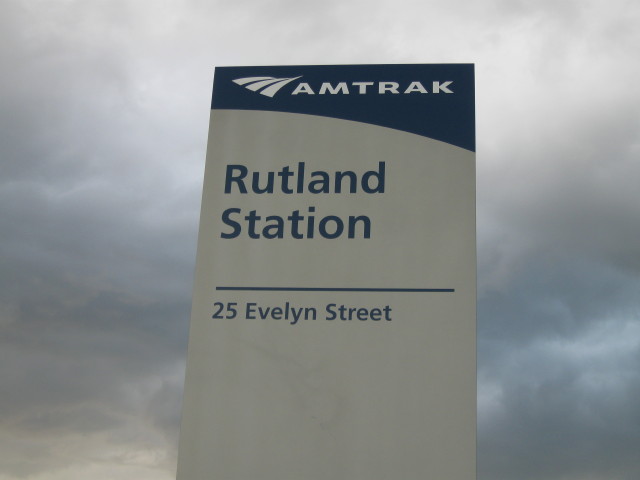
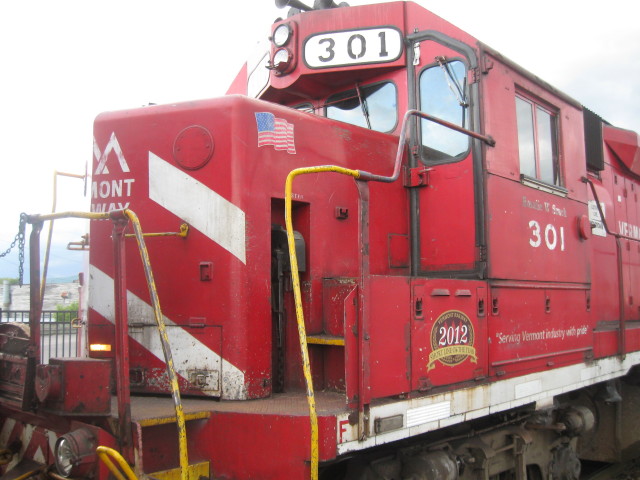
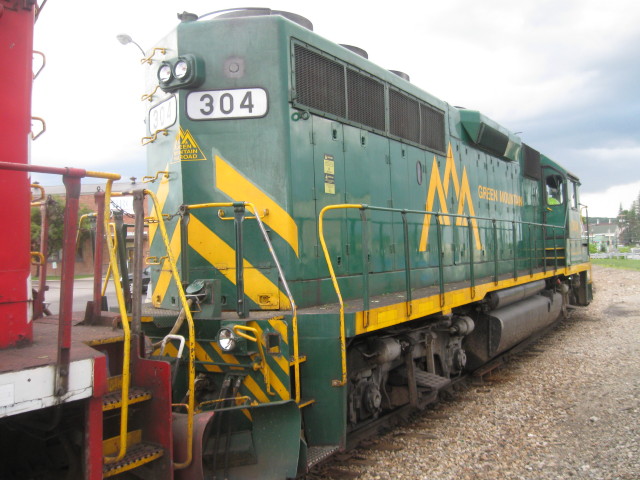
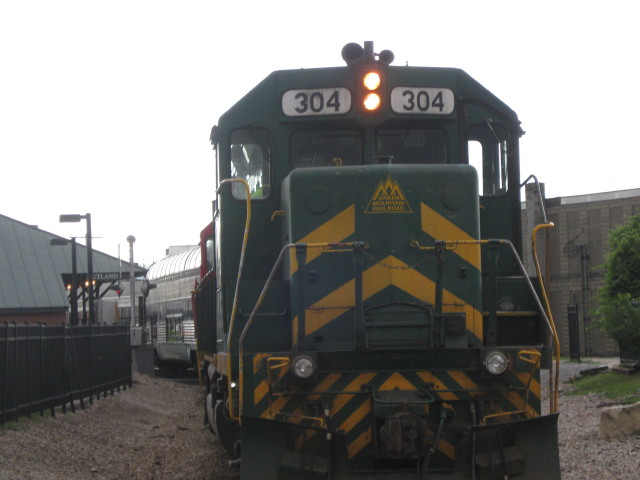
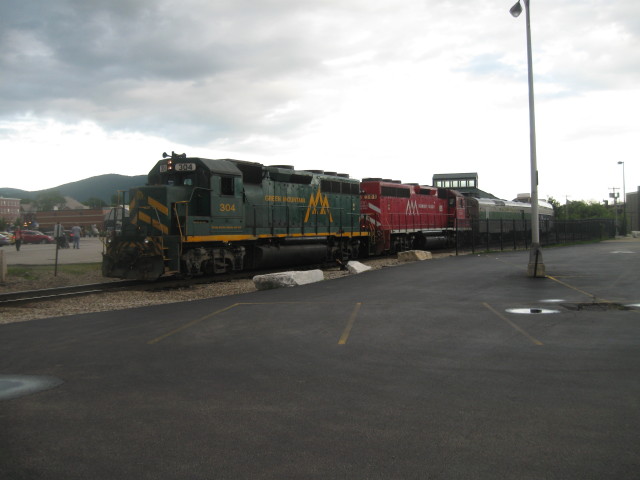
After Chris
and I left the Rutland Amtrak station, we
decided that carry out from KFC would hit the
spot for dinner. We stopped at the KFC on So.
Main St to pick up our chicken dinner and then
headed to the motel and our room to relax, eat
dinner and watch some TV.
Then it was the end of a
exciting day of train riding.
Tomorrow no train ride, I
will be taking a tour by bus to several tourist
highlights.
Dover
Harbor web site.
Somesay
Island Railway, UK web site.
Scenic Vermont
Train Rides web site.
Thanks for reading !
